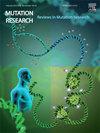In silico identification of multidrug resistance gene (MDR)-targeted transposon miRNAs in human cancer
IF 1.5
4区 医学
Q4 BIOTECHNOLOGY & APPLIED MICROBIOLOGY
Mutation Research-Fundamental and Molecular Mechanisms of Mutagenesis
Pub Date : 2025-01-01
DOI:10.1016/j.mrfmmm.2025.111903
引用次数: 0
Abstract
miRNAs are small RNA molecules that regulate gene expression and play important roles in various biological processes in cells. The discovery of miRNAs is also of great importance in cancer research. miRNAs enable the development of new approaches in cancer treatment by regulating gene expression in cancer cells and have an important place in cancer development, treatment, and diagnosis. Multidrug resistance (MDR) in cancer is associated with the overexpression of ATP-binding cassette (ABC) transporter proteins in cancer cells. MDR contributes to the dysregulation of ABC transporter proteins, and miRNAs mediate MDR in various cancers, resulting in drug resistance. In this study, it was aimed to identify new miRNA sequences in genes associated with multidrug resistance in cancer using in silico method. After obtaining the mature human miRNA sequences in the miRBASE database, BLAST analyses were performed with these sequences for five multidrug resistance genes (ABCB1, ABCC3, ABCC10, ABCC11, ABCG2) known to be associated with cancer. The RNAhybrid tool was used to find the minimum free energy hybridization of gene and miRNA. The target genes of pre-miRNAs and the metabolic pathways in which the target genes play a role were identified with GeneMANIA, SRplot, miRTargetLink programs. Phylogenetic trees of miRNAs belonging to genes were created using the MEGA X software. Secondary structures of pre-miRNA sequences were determined using the RNAfold Web Server program. According to the data obtained from the study, 107 miRNAs associated with multidrug resistance were identified in human cancers. Transmembrane transporter, drug transport and response to drug functions, and metabolic activities of miRNA-related pathways of MDR genes in various cancer types were determined. Multidrug resistance (MDR) in cancer is often associated with overexpression of ABC transporter proteins, which can lead to failure of cancer treatments. Additionally, the relationship of miRNAs with ABC transporter proteins constitutes an important research area to understand the mechanisms of drug resistance and develop new treatment strategies.
人类肿瘤中多药耐药基因(MDR)靶向转座子mirna的计算机鉴定
mirna是调节基因表达的小RNA分子,在细胞的各种生物过程中发挥重要作用。mirna的发现在癌症研究中也具有重要意义。mirna通过调节癌细胞中的基因表达,为癌症治疗开辟了新途径,在癌症的发展、治疗和诊断中发挥着重要作用。癌症的多药耐药(MDR)与癌细胞中atp结合盒(ABC)转运蛋白的过度表达有关。MDR导致ABC转运蛋白失调,mirna介导多种癌症的MDR,导致耐药。在本研究中,旨在利用计算机技术鉴定癌症多药耐药相关基因中的新miRNA序列。在miRBASE数据库中获取成熟的人类miRNA序列后,利用这些序列对已知与癌症相关的5个多药耐药基因(ABCB1、ABCC3、ABCC10、ABCC11、ABCG2)进行BLAST分析。使用RNAhybrid工具寻找基因与miRNA的最小自由能杂交。通过GeneMANIA、SRplot、miRTargetLink等程序鉴定pre-miRNAs的靶基因及其代谢途径。使用MEGA X软件建立了属于基因的mirna的系统发育树。使用RNAfold Web Server程序确定pre-miRNA序列的二级结构。根据这项研究获得的数据,在人类癌症中发现了107种与多药耐药相关的mirna。测定不同类型肿瘤中MDR基因的跨膜转运、药物转运及对药物功能的反应、mirna相关通路的代谢活性。癌症中的多药耐药(MDR)通常与ABC转运蛋白的过度表达有关,这可能导致癌症治疗的失败。此外,mirna与ABC转运蛋白的关系是了解耐药机制和制定新的治疗策略的重要研究领域。
本文章由计算机程序翻译,如有差异,请以英文原文为准。
求助全文
约1分钟内获得全文
求助全文
来源期刊
CiteScore
4.90
自引率
0.00%
发文量
24
审稿时长
51 days
期刊介绍:
Mutation Research (MR) provides a platform for publishing all aspects of DNA mutations and epimutations, from basic evolutionary aspects to translational applications in genetic and epigenetic diagnostics and therapy. Mutations are defined as all possible alterations in DNA sequence and sequence organization, from point mutations to genome structural variation, chromosomal aberrations and aneuploidy. Epimutations are defined as alterations in the epigenome, i.e., changes in DNA methylation, histone modification and small regulatory RNAs.
MR publishes articles in the following areas:
Of special interest are basic mechanisms through which DNA damage and mutations impact development and differentiation, stem cell biology and cell fate in general, including various forms of cell death and cellular senescence.
The study of genome instability in human molecular epidemiology and in relation to complex phenotypes, such as human disease, is considered a growing area of importance.
Mechanisms of (epi)mutation induction, for example, during DNA repair, replication or recombination; novel methods of (epi)mutation detection, with a focus on ultra-high-throughput sequencing.
Landscape of somatic mutations and epimutations in cancer and aging.
Role of de novo mutations in human disease and aging; mutations in population genomics.
Interactions between mutations and epimutations.
The role of epimutations in chromatin structure and function.
Mitochondrial DNA mutations and their consequences in terms of human disease and aging.
Novel ways to generate mutations and epimutations in cell lines and animal models.

 求助内容:
求助内容: 应助结果提醒方式:
应助结果提醒方式:


